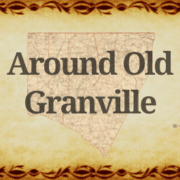The Local Skinny! Around Old Granville: History Of Cedar Walk
Think about it for a minute: Is is easier to remember what you ate for breakfast this morning or to visualize in your mind the house where you grew up? Many historians rely on people’s long-term memories to piece together the past, and that is exactly what Mark Pace did to try to learn more about Cedar Walk, a home in Williamsboro that was torn down in 1967.
He and WIZS’s Bill Harris talked about the origins of the home, which was called Blooming Hope when it was a school for girls during its early days. During the Depression era, it was the oldest house standing in Vance County, Pace said during the Around Old Granville segment of Thursday’s The Local Skinny!
Pace, North Carolina Room Specialist at the Richard Thornton Library in Oxford, said he was able to talk to some folks who’d lived in the house in the 1940’s and ‘50s who were able to describe the interior floor plan. The Library of Congress has photographs of the home taken in the 1930’s that show a fairly plain, two-story frame home with a covered front porch.
“It’s a shame it’s not here – it’s associated with so many important people,” Pace said. Revolutionary War leaders, a former governor and the minister who helped establish the Presbyterian Church in the state have ties to Cedar Walk, so named because of the lane of cedar trees that lined the walk up to the home.
By most accounts, the home probably was built around 1780, Pace said, based on the style and size of the structure. If the structure were still standing, the wood could be aged using tree-ring dating, he added, but most likely it would have been a contemporary of St. John’s Episcopal Church, which was built in 1773.
It was later purchased by Col. Robert Burton, who had fought in the Revolutionary War.
Burton was a businessman and UNC has a ledger in which he recorded some of his business dealings, Pace said. One notable entry is the sale of a horse to a fellow named Daniel Boone.
One of Burton’s nephews came to live at Cedar Walk. His parents died and Hutchins Burton came to live at Cedar Walk. He became North Carolina’s 22nd governor, serving from 1824-1827.
When the Bullock family bought the home in 1828, they made an addition to the home, which Pace described as “one of the great old plantation houses in Vance County.” Although the house no longer stands, the land remains in the Bullock family.
The house fell into disrepair, probably for a couple of reasons, Pace noted. One reason was the lack of electricity, which would have been a costly endeavor. But the second reason, he said, is because people said the house was haunted.
Visit the Library of Congress website and search “Cedar Walk” to see photographs.
CLICK PLAY!

